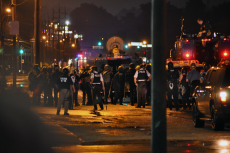
Last summer an unarmed black teenager was fatally shot by a white policeman in Ferguson, America. The protests which erupted through the small Missouri city soon spread to other places throughout the nation, as well as attracting world-wide attention. The uncertain nature of the shooting wasn’t the only reason for the controversy—it also brought to the surface long-term tensions and concerns about corruption through the whole justice system in America.
On 9th August 2014 a convenience store robbery was reported on police radio. Eighteen year-old Michael Brown, together with Dorian Johnson, had stolen a pack of cigarettes and pushed a store clerk before fleeing the scene. A few minutes later, officer Darren Wilson was driving nearby when he encountered Brown and his friend Johnson walking in the middle of the street. He stopped to tell them to move to the pavement, but soon recognised their description from the radio call. What happened next is very unclear, as each witness gives a different version of events. What is certain is that an argument took place through the police car window and shots were fired before Brown and Johnson fled, with Wilson giving chase on foot. At some point, Brown turned back to face the police officer, who shot him multiple times. Witnesses including Johnson claim that Brown had surrendered and has his hands in the air at the time of the shooting; Wilson insists that Brown was charging towards him, and that he was only protecting himself.
Within an hour a crowd of hundreds had gathered around the crime scene. Brown’s body was left in the street for four hours and people demanded answers about what had taken place. Ferguson has a majority black population, and the shooting was seen as yet another abuse by the overwhelmingly white police force. For the next four nights there were continuous protests throughout the city. Many were peaceful demonstrations, but others turned to rioting and looting with two dozen businesses destroyed. This provoked a heavy police response, with officers in riot gear using tear gas and rubber bullets against the crowds. On 24th November a new wave of protests was sparked by the jury finding Wilson innocent of wrongly shooting Brown.
These events seemed to further confirm the wide gulf between the people and the police. People’s concerns were confirmed in March 2015 when a report by the US Department of Justice condemned Ferguson’s police department as “institutionally racist”. In a city of 21,000 people, two thirds of whom were black, forty-nine of Ferguson’s fifty-three police officers were white. Although only 67% of the population is African American they made up 93% of arrests between 2012 and 2014. Police were accused of using excessive force against black people, with nine of out ten uses of force directed against African Americans. There were also widespread arrests without probable cause.
Sadly these figures are not unique to Ferguson but reflect national trends. In 2009 the incarceration rate for black men was six times higher than that of white men. In 2012 several university studies found that blacks receive considerably longer sentences than whites for the same or lesser offences. It’s no surprise then that Ferguson was not the only city to see protests in the last year. In December 2014 a huge crowd marched through New York against police violence, inspired both by the Brown shooting and the death of Eric Garner at the hands of police. Although Hispanic and black people make up 50% of New York’s population, they accounted for 81% of arrests between 2001 and 2013. In April 2015 the city of Baltimore erupted in protest against the death of Freddie Gray whilst in police custody. Later six officers were found guilty of his death, and a federal investigation found the Baltimore police department engaged in discriminatory practices.
These and other protests unleashed a worldwide debate on race and police work. Nationwide political movements like Black Lives Matter have grown in prominence, and the issue of police brutality continues to make headlines. However, a year on from the Michael Brown shooting and it’s unclear how much has changed in Ferguson. Despite many calls for body cameras, no police officers are wearing them. Attempts to recruit more African American police officers have failed. At a recent memorial protest, another young black man was shot by police. It’s obvious that there’s still a long way to go.
Image: https://upload.wikimedia.org/wikipedia/commons/2/29/Ferguson_Day_6,_Picture_53.png

0 Comment:
Be the first one to comment on this article.